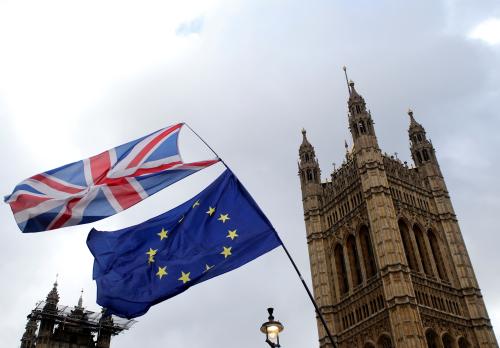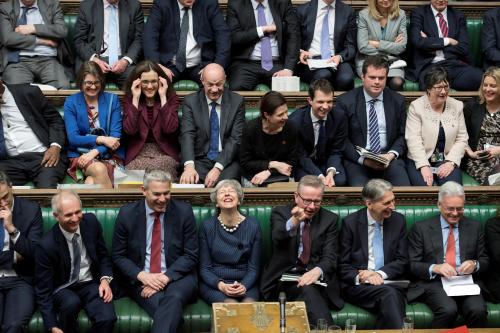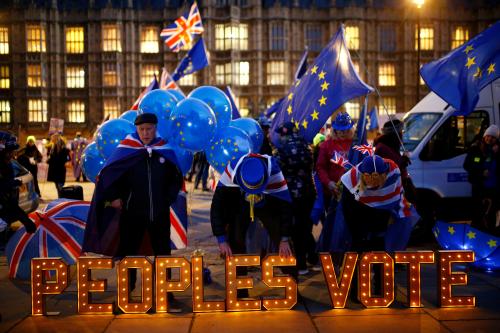After the British Parliament defeated Prime Minister Theresa May’s deal with the European Union for a second time in mid-March, it narrowly supported a request to the EU for an extended Brexit deadline. This week, May asked for a three-month extension and her European counterparts granted a “flextension.” The deadline was pushed back two weeks, with leaders giving May until April 12 to pass her deal or “indicate a way forward.” If the deal does pass, she has until May 22 to adopt implementing legislation. Although March 29 is no longer the cliff edge, the Brexit endgame is still heading to the wire with no clear way forward.
Will there be an extension?
Yes. On March 20, May sent a letter to European Council President Donald Tusk requesting a technical extension until June 30 to allow time for the British Parliament to ratify her deal. She rejected a longer extension if the vote failed, given an aversion to holding European Parliament elections in late May, but did not explain what would happen in that scenario. Her request contravened advice from European Commission President Jean-Claude Juncker, who said May 22 was the EU’s limit. She had no answers for these issues when she met leaders at a European Council summit on March 21.
At the summit, EU-27 leaders agreed to extend the departure date by two weeks to April 12, the legal deadline by which Britain must decide whether to participate in European Parliament (EP) elections. If May’s deal is passed by March 29, the deadline will shift to May 22—allowing time for the British Parliament to pass implementing legislation and for the European Parliament to ratify the deal. If her third attempt fails, Britain has a short window to determine a new plan (including a request for a lengthy extension contingent on holding European elections) or prepare for a no-deal Brexit.
After efforts by the British Parliament to take control, the EU is now setting the timetable. The marathon summit discussions—held without May—reflected cracks in the EU’s previous unity, although they coalesced around a common approach. In particular, French President Emmanuel Macron assumed a hard line while German Chancellor Angela Merkel, Dutch Prime Minister Mark Rutte, and Tusk were more conciliatory.
What happens next?
May must first win cabinet backing for the EU’s offer, which seems likely. She must also pass through both houses the statutory instrument required to amend U.K. legislation that set March 29 as Brexit day, which also seems likely. The bigger challenge remains getting her deal through Parliament, which was not helped by her March 20 statement blaming members of Parliament (MPs) for their intransigence.
On March 25, the government will present a motion to Parliament. As before, MPs can amend this motion with their preferred approaches—which may include indicative votes on options. At some point during the week, MPs will take their third meaningful vote on May’s deal. If it passes, she needs the coalition of supporters to hold together long enough to adopt implementing legislation.
Will May’s deal pass?
Probably not, as May must persuade at least 75 MPs to back her deal. She will build on lobbying efforts undertaken in anticipation of a third vote this past week, which was scuppered by the surprise ruling of Speaker John Bercow barring the government from bringing forward a motion that was not “fundamentally different” from the last version. Attorney General Geoffrey Cox sought to reassure Brexiteers by updating his legal advice, suggesting the Vienna Convention would allow the U.K. to leave the backstop if there was a “fundamental change of circumstance.” The government is continuing talks with Northern Ireland’s Democratic Unionist Party (DUP), including discussions of a “Stormont Lock” (suggesting any EU regulations applied to Northern Ireland would be extended to the rest of the U.K.), a role for the Northern Ireland Assembly (which has been suspended for over two years), and reported pledges of additional funding for the region. Reflecting the lack of trust in this process, all sides are seeking to ensure current promises will be upheld in the future.
There is still no clarity on May’s Plan B. In remarks after the summit, Tusk said all options remain on the table until April 12. At that point, the U.K. must pass the deal, pursue a no-deal Brexit, revoke Article 50, or accept a long extension. When reporters asked May about his comments, she ruled out revoking Article 50.
There is still no clarity on May’s Plan B.
Why are European Parliament elections so central to Brexit deadlines?
In anticipation of Brexit, the EU planned institutional changes to its legislature—including reducing the current number of members and reallocating some vacated British seats to other countries. When European leaders considered possible extension dates, they focused on the implications for EP elections. If the U.K. remains in the EU but does not hold EP elections, it could disenfranchise EU nationals living in the U.K. and make EU decisions taken with an incomplete parliament subject to legal challenge. At the same time, there are concerns that British EP elections could lead to pro-Brexit members who hinder debates about the EU’s new budget and planned institutional reforms. European leaders also worry a disastrous no-deal Brexit on the eve of EP elections could fuel populist support across the continent.
Key dates are:
- April 12: Deadline for the U.K. to declare its intention to participate in EP elections (if deal is not adopted), including beginning domestic preparations for elections
- April 18: Last business day of current European Parliament
- May 22: Deadline for the U.K. to conclude Brexit ratification process (if deal is adopted)
- May 23-26: European Parliament elections
- July 2: First business day of new European Parliament
Is no-deal Brexit still a serious possibility?
The cliff edge has been pushed from March 29 to April 12. European leaders, despite the tough talk of Macron and others, do not want to be blamed for a catastrophic no-deal Brexit or harm the Irish border. The British Parliament has also (narrowly) expressed its opposition to this outcome. However, it remains a possibility: May notably refused to rule out the option when she arrived at the summit and the EU has hardened its insistence on conditionality for a longer extension. It could also happen by accident.
The U.K. government is increasing its contingency planning for a no-deal Brexit, with press reports citing a taskforce in a nuclear-proof bunker under the Defense Ministry with 3,500 troops on standby, possible food and water shortages, and teachers prepared to care for stranded children whose parents may be trapped in gridlock. Meanwhile, the deputy speaker advised MPs to take taxis or travel with colleagues amid increasing security concerns in the final days of Brexit debates.
Will there be no Brexit or a second referendum?
Over 3 million people have signed a petition calling for the government to revoke Article 50 and remain in the EU, with the rapid pace of additional signatures causing the website to crash. On March 23, hundreds of thousands of people will march in London to call for a second referendum. However, there is not sufficient support in Parliament for either option.
The Brookings Institution is committed to quality, independence, and impact.
We are supported by a diverse array of funders. In line with our values and policies, each Brookings publication represents the sole views of its author(s).











Commentary
Brexit endgame: European Union takes back control
March 22, 2019